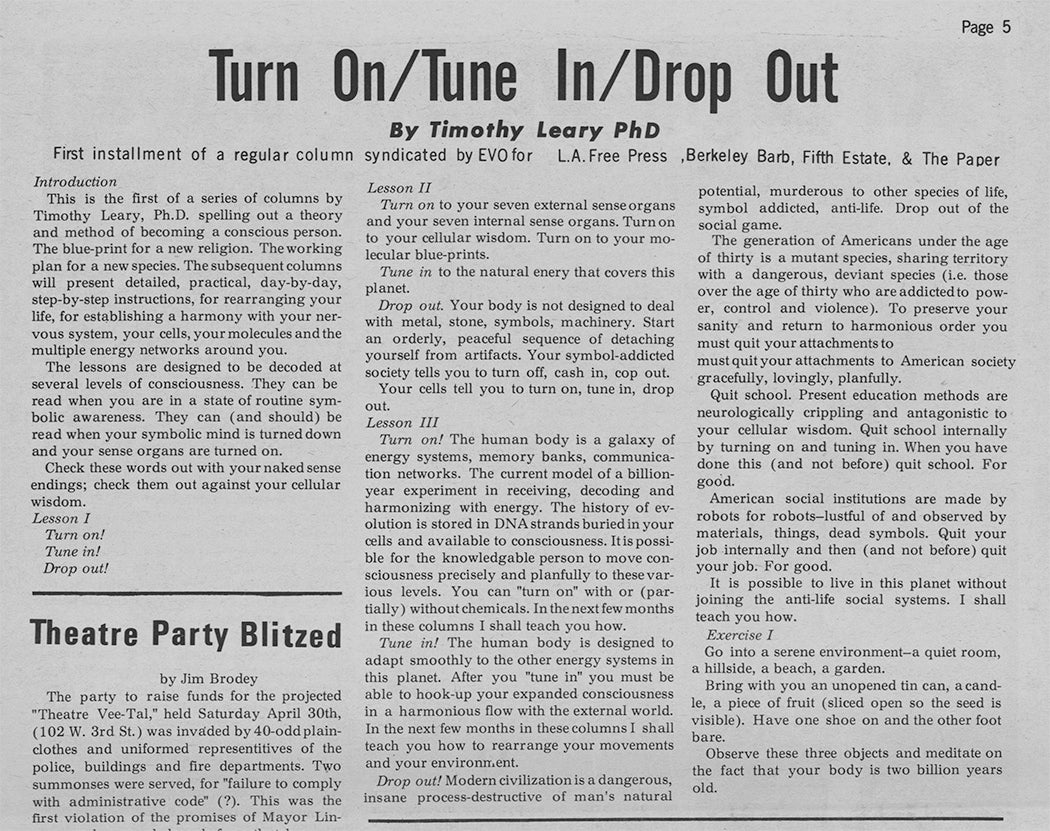The East Village Other (EVO) was founded in 1967 by a number of people who became well-known authors of the Underground Press: Allan Katzman, Walter Bowart, and John Wilcock. At its peak, the paper published 60,000 copies of individual papers. The EVO blends psychedelic interests with revolutionary politics. It regularly published interviews with Timothy Leary and Allen Ginsberg. It also became known for the sex ads that populated much of the back of the newspaper.
One regular column featured the images and biographies of East Village females. Titled “Slumgoddess,” the column regularly depicted scantily-clad (and often nude) images of local, sexually liberated and counterculturally inclined women. Although the subject of much controversy, Allan Katman felt that the sex ads in the back of the paper played an important role for the “lonely people of New York,” who relied on the paper for human companionship. The paper also became well-known for publishing underground comics. Well known artists like R. Crumb and Art Spiegelman published work with the EVO.

The EVO was largely responsible for initiating the Underground Press Syndicate (UPS), a nation-wide syndication network that made it possible for papers in small towns to emerge all over the country. In May 1966, the East Village Other began a column that would be syndicated across the country in five other underground papers. Timothy Leary started the column “Tune in / Turn on / Drop out” in part to help his defense in a recent drug charge. Leary intended to help readers achieve consciousness expansion without the use of drugs. The column was short lived, but appears to have sparked the idea for the UPS. Allan Katzman suggested the more explicit idea for an underground syndicate in the EVO in June 1966. Walter Bowart of the EVO claimed to have come up with the name spontaneously. After seeing a United Parcel Service truck drive by during an interview he replied, “We’re… ah… UPS – the Underground Press Syndicate.”
For a small fee, papers in the UPS could reprint any articles from any other members’ papers free of charge. This provided enough content for underground publishers in small cities and towns to produce a paper. The idea that editors could reprint any article from other member papers reflected a belief popular among underground authors and writers that copyright laws were obtrusive and out of date.
Because of the EVO’s longevity (it lasted until 1972), popularity, location, and role in the UPS, the paper is an excellent resource for anyone studying the personalities and events characteristic of the American counterculture. The EVO carried on a close relationship with Timothy Leary. As the counterculture was amping up in the late 1960s, Leary was finishing his time at the Millbrook estate in upstate New York where he was running “experiments” with LSD. The paper followed closely his numerous run-ins with the law, advertised on behalf of the campaign to raise bail when he was finally arrested, and when the Weather Underground broke Leary out of a California prison, the EVO announced on its cover, “Proud Eagle Flies Free.” (September 15, 1970).

The EVO is also an excellent resource for documentation of countercultural events. Take the March on Washington, where tens of thousands of activists stormed and occupied the front steps of the Pentagon. The paper helped Ed Sanders, a member of the band The Fugs and an owner of the Peace Eye Bookstore, raise funds to perform the Exorcism of the Pentagon that took place at the march. Perhaps because of its proximity, the EVO advertised and documented to a greater extent than many other papers the best-known countercultural event, Woodstock, also known as “The Aquarian Exposition.” The paper printed advertisements for the festival and a thorough review of the event by John Hilgerdt (August 13, 1969, August 20, 1969). For Hilgerdt, Woodstock was only the beginning of a mass countercultural movement. He writes, “A few thousand of the absolutely most together and peaceful and beautiful heads in the world are gathered in a grand tribal new beginning… All the petty bullshit that before kept us apart vanished and for the first time we were free” (August 20, 1969, 7).
Weekly Newsletter
The EVO provides documentation of the activities of one of the most active countercultural communities in the US in New York’s East Village. Although there were remnants of the counterculture that lived on after the EVO had closed its doors, by the time the paper ceased publication, the countercultural movement had already begun to fade. Because the paper was one of the earliest underground papers, and because its lifespan covers the rise and fall of the counterculture, the paper is a good resource for gauging the general attitudes of the counterculture. It’s an excellent resource for those studying the aesthetics of the counterculture, especially comics, and its proximity to New York and role in the UPS make it an excellent reference for those interested in countercultural leaders and in many of the events that have become emblematic of the counterculture more generally. Read The East Village Other and other countercultural publications in the Independent Voices archive from Reveal Digital.
Support JSTOR Daily! Join our new membership program on Patreon today.







